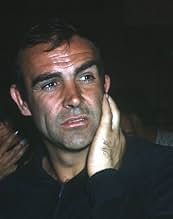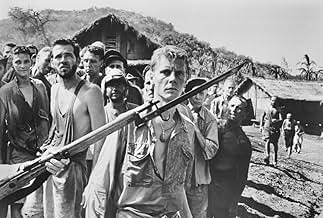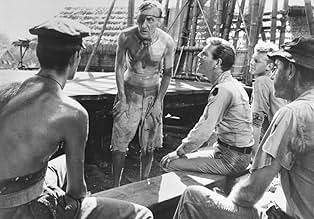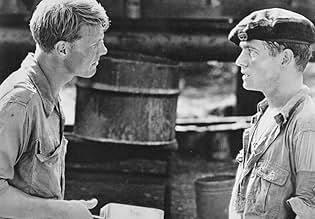VALUTAZIONE IMDb
7,5/10
5336
LA TUA VALUTAZIONE
Aggiungi una trama nella tua linguaFast-talking wheeler-dealer Corporal King is stuck in a Malaysian P.O.W. camp during World War II and uses bribery and larceny to take de-facto control of the camp.Fast-talking wheeler-dealer Corporal King is stuck in a Malaysian P.O.W. camp during World War II and uses bribery and larceny to take de-facto control of the camp.Fast-talking wheeler-dealer Corporal King is stuck in a Malaysian P.O.W. camp during World War II and uses bribery and larceny to take de-facto control of the camp.
- Candidato a 2 Oscar
- 3 candidature totali
Joe Turkel
- Dino
- (as Joseph Turkel)
Michael Stroka
- Miller
- (as Mike Stroka)
Recensioni in evidenza
This film, the best of 1965, was tough and disturbing and seriously under-rated. Great performances and a haunting soundtrack. George Segal, one of the best actors of the 60's and 70's creates an insidious yet charming character who runs things in the camp. James Fox (excellent actor who quit for many years on some kind of spiritual journey) is superb as is Tom Courtney and even Patrick O'Neal (who has never been impressive in any other film I can think of) delivers a punch as Max the stooge.
Bryan Forbes created a somber world of dog eat dog that should have been up for a host of awards. Throw in John Mills, James Donald and other familiar faces and you have a near-classic. A 9 out of 10. Best performance George Segal. Well worth your time.
Bryan Forbes created a somber world of dog eat dog that should have been up for a host of awards. Throw in John Mills, James Donald and other familiar faces and you have a near-classic. A 9 out of 10. Best performance George Segal. Well worth your time.
"King Rat" is certainly NOT a fun nor enjoyable movie to watch. Now I am not saying it's bad nor should you avoid it...just understand that the film depicts a Japanese POW camp...and there's no way you could make that fun to watch.
The setting is a POW camp near Singapore. There's absolutely no place for the mostly British as well as a few American prisoners to run to and the Japanese keep rather lax security because of this. The prisoners also are dying rapidly due to starvation, no medications and the hellish conditions. However, in the midst of this, Corporal King (George Segal) manages to thrive. This is because he is a schemer and a survivor...operating a black market operation to get food and whatever he really needs. One of the other prisoners, Lt. Grey (Tom Courtenay), is just the opposite. Grey LOVES rules, power and playing a little god in the camp...and he wants to keep order, discipline and King under his control. To Grey, getting King to follow the rules and give up his black market activities seems to be his greatest aim. As for King, he pretty much ignores Grey and does what he does best...survives. And, if that means selling rat meat or eating dog, well, he'll do it in order to live.
As the description would indicate, the film is often rather grim. It's also an interesting character study of several of the inmates...not just Grey and King. Well acted, well made and well worth seeing...provided you can stand watching it. Now this is NOT one of the very worst war films...it's not nearly as bad as "Saving Private Ryan", "Burmese Harp" nor "Fires on the Plain"...but it still is tough. One of Segal's best.
The setting is a POW camp near Singapore. There's absolutely no place for the mostly British as well as a few American prisoners to run to and the Japanese keep rather lax security because of this. The prisoners also are dying rapidly due to starvation, no medications and the hellish conditions. However, in the midst of this, Corporal King (George Segal) manages to thrive. This is because he is a schemer and a survivor...operating a black market operation to get food and whatever he really needs. One of the other prisoners, Lt. Grey (Tom Courtenay), is just the opposite. Grey LOVES rules, power and playing a little god in the camp...and he wants to keep order, discipline and King under his control. To Grey, getting King to follow the rules and give up his black market activities seems to be his greatest aim. As for King, he pretty much ignores Grey and does what he does best...survives. And, if that means selling rat meat or eating dog, well, he'll do it in order to live.
As the description would indicate, the film is often rather grim. It's also an interesting character study of several of the inmates...not just Grey and King. Well acted, well made and well worth seeing...provided you can stand watching it. Now this is NOT one of the very worst war films...it's not nearly as bad as "Saving Private Ryan", "Burmese Harp" nor "Fires on the Plain"...but it still is tough. One of Segal's best.
I saw this grainy black and white film sometime in 1967 one steamy evening in a tin hooch Army movie theatre at TSN airfield on the outskirts of Saigon. The movie was punctuated by the sounds of mortars on the perimeter and the occasional flash from an aerial flare. I never forgot it. It rang true there. So true that no-one could say a word after. We just got drunk -- as usual. I haven't talked to many others who saw this movie. It hit right in the middle of the rising tide of despair over Vietnam. And since it wasn't actually an anti-war movie, I think it went nowhere. I believe it's origin is a short novel, possibly autobiographical by J.B. Clavell, author of Tai Pan and other sagas set in the 19th C orient. No matter what George Segal has done since, I have known that he has the heart of a rat. His King was a natural ruler in a perverse state of nature -- and his fate the fate of all maverick rulers in the end. If you can find it and see it, it will take on the character of a lost dream.
I saw "King Rat" on television shortly before going to Vietnam. A few months later I was reading the James Clavell novel while serving on DaNang Air Base with air force communications intelligence. It struck me that this book and this movie, which was "researched" by James Clavell when he was a POW in a camp near Singapore during World War II, have the real feel of what it is to be surrounded by enemy forces one almost never sees while being kept isolated on a hot, humid, dusty encampment It's an environment that brings out the best and the worst in mankind. The novel, the movie, and my own war zone experience also point out that adapting to a war zone and mastering the skills that enable one to survive and even prosper there do not necessarily mean that the individual will subsequently be adaptable to "civilization" when he returns to it. The novel, the movie, and my own experiences also raise the questions that are raised in "The Man in the Gray Flannel Suit" (and even in "Rambo" for that matter): Which is more of a challenge and which is the "real" life: adapting to the war zone as a youth or the expectations by "civilization" that you readjust to life back in "the world" as if nothing had happened?
It has always bothered me that King Rat is so underrated. On one list of top the thousand films in history, it gets no mention. I think it's because George Segal's character, Corporal King wasn't a totally likable person. He is not the standard Hollywood hero. But he is a hero of mine. Were I in that prison camp, I guarantee you, I would have been Corporal King's best friend. One thing I learned in life was how to survive, and everyone around Corporal King survived. The movie misses a very important point that was in James Clavell's novel on which it is based. In case the war turned bad for the Japanese and they started taking revenge on the prisoners, King had planned an escape route. Not just for himself, for everyone close to him. Put that in the film and you've got a major American hero. The movie is totally cliché free. One never knows where it is going or how it is going to end. Winning the war, you see, will not guarantee the safety of the prisoners. How it ends is perfectly logical in retrospect, but difficult to predict. It is a near perfect motion picture.
Lo sapevi?
- QuizDue to the cast, director and setting, this is often assumed to be a British movie, but it was entirely filmed in California.
- BlooperThe shoulder patch that Cpl. King (George Segal) is wearing is that of the 34th Infantry Division (Red Bull). The 34th ID served in the European Theater of Operations, not in the Pacific. The 34th ID patch is a black Mexican water jug called an "olla" with a red bull's skull superimposed. Almost all the POWs at Changi were British or Commonwealth soldiers captured at the surrender of Singapore on Feb. 15, 1942, but there also were POWs from the Netherlands East Indies, which surrendered in March. The only sizable U.S. unit at Changi was Co. E, 2nd Btn, 131st Field Artillery Regt., part of the Army's 36th ID (the "Texas Division"). The Second Battalion, which became known as the Texas National Guard's "Lost Battalion," was detached from the 36th ID in the States and shipped to the Pacific in November 1941, but when the Japanese attacked the Philippines in December, the battalion's convoy was diverted from Manila to Brisbane, Australia. In January the battalion was sent to Java, in the Netherlands East Indies. The battalion was the only U.S. ground unit in Java when the NEI surrendered to the Japanese on March 9, 1942. Most men in the battalion were transferred to Singapore later that year and, along with thousands of British and Commonwealth soldiers, were used by the Japanese as slave labor to build the infamous "Death Railway" connecting Bangkok to Rangoon. Company E of the 2nd Battalion, separated from the rest of the unit on Java, was at Changi briefly in October-November 1942 before being sent to Japan as slave laborers. It would be plausible that Cpl. King was a member of 2nd Battalion, 131st Field Artillery, and that the movie's costumers got the wrong division patch for his uniform.
- Curiosità sui crediti[Prologue] This is not a story of escape. It is a story of survival.
It is set in Changi Jail Singapore, in 1945
The Japanese did not have to guard Changi as a normal prison of war camp. The inmates of Changi had no friendly Swiss border or any other neutral country within reach. They were held captive not so much by high walls, or barbed wire, or machine-gun posts, but by the land and sea around them - and the jungle was not neutral, nor was the ocean.
They did not live in Changi. They existed. This is the story of that existence.
- ConnessioniFeatured in A Walk on the Moon - Complice la luna (1999)
- Colonne sonoreAdeste Fideles
(uncredited)
Written by Frederick Oakeley (1841)
Variation sung in distant background by POWs
I più visti
Accedi per valutare e creare un elenco di titoli salvati per ottenere consigli personalizzati
- How long is King Rat?Powered by Alexa
Dettagli
- Tempo di esecuzione2 ore 14 minuti
- Colore
- Proporzioni
- 1.85 : 1
Contribuisci a questa pagina
Suggerisci una modifica o aggiungi i contenuti mancanti



































